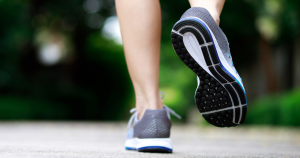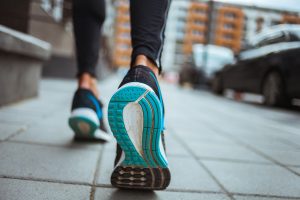Choosing the Right Shoe for You: Tips for Shoe Shopping for Orthopedic Health
 Our feet are one of the most under appreciated parts of our body. Each foot contains 26 bones, 29 muscles, and 30 joints that support us throughout the day. From running to hiking and simply standing, our feet carry out several tasks to get us through the day. The average American spends about 56 percent of their day on their feet!
Our feet are one of the most under appreciated parts of our body. Each foot contains 26 bones, 29 muscles, and 30 joints that support us throughout the day. From running to hiking and simply standing, our feet carry out several tasks to get us through the day. The average American spends about 56 percent of their day on their feet!
If we need to spend over half of our day on our feet, we will need shoes that can support us and keep us moving forward. In the blog post below, Orthopaedic Hospital of Wisconsin physical therapist Michael Branda, PT, DPT, discusses choosing the proper footwear and what to consider while shoe shopping.
Choosing the Right Shoe for You
 Choosing the right pair of shoes is not always easy, with hundreds of shoes to choose from. The choice can be overwhelming and daunting. It is a bit of a “Goldie Locks and The Three Bears” situation, with endless bowls of porridge to try. The risk of buying shoes, because they felt good in the store for five minutes, does not guarantee they will feel like that all day. However, with some guidance, you can narrow your search and choose the shoe that feels “just right”.
Choosing the right pair of shoes is not always easy, with hundreds of shoes to choose from. The choice can be overwhelming and daunting. It is a bit of a “Goldie Locks and The Three Bears” situation, with endless bowls of porridge to try. The risk of buying shoes, because they felt good in the store for five minutes, does not guarantee they will feel like that all day. However, with some guidance, you can narrow your search and choose the shoe that feels “just right”.
Here are some considerations while shoe shopping.
Consider Your Activity Level
What will you be using the shoes for? If you’re going to be doing a lot of walking or running, you’ll need a shoe to give you a good balance of cushion and support. If you need solely walking shoes, you can get away with less cushion, but you may need more support.
Get Your Feet Measured
Your foot size and shape can change over time, so it’s a good idea to measure your feet to get a more accurate sizing. My advice would be to use a Brannock Device to measure the length and width of your foot. From there, consider going up ½ size from your measurement. For example, if you measure as a size 11, you might consider trying on 11.5 and adjust from there.
Rule of thumb (pun intended): there should be about a thumb width of space between your longest toe and the tip of the shoe.
Try on Different Pairs of Shoes

Don’t just buy the first pair of shoes that you see (think “Goldie Locks”). Try on at least three to five shoes while at the store, and don’t be afraid to walk around in them to see how they feel. Shoes that are too cushioned (squishy) may bottom out and make your feet feel tired at the end of the day. Very supportive shoes may be too stiff and uncomfortable to stand or walk in all day. You want to find that balance of cushioned and supportive.
Pay Attention to the Width of the Shoe
That letter that comes after the number for your size (e.g. 11D), indicates the shoe’s width. Most men’s shoes are a D width, while most women’s shoes are a B width. If the shoe feels too tight or restrictive around the sides of your feet, you might want to consider going with a larger width. A Brannock Device will also determine the width of your foot.
Look for Shoes With Support That YOU Need
A lot of shoe companies advertise arch support in their shoes, however many people with flat feet (pes planus) may find high arch support to be too intrusive. Those individuals with higher arches may require higher arch support to make the shoe comfortable, but this is not guaranteed. This is why trying on many different types of shoes will help you find what your feet like. No one shoe is the best for everyone.
Money Matters…Sort Of
Shoes can get very expensive, especially those marketed toward being an “orthopedic” shoe or specializing in support features (I’m looking at you New Balance). However, your pair of shoes probably does not need to cost $200+. With that said, you wouldn’t want to opt for the cheapest option as the build quality may not be the best and long-lasting. I often recommend starting at the middle of the pack pricing when looking for shoes, around the $120-$140 range. Starting there will get you at least a good enough shoe to last several months of frequent use.
If you have any foot problems or concerns, such as foot pain secondary to flat feet, bunions, or past injuries, talk to your doctor, podiatrist, or physical therapist about the best shoes for you. They may recommend special shoes or orthotics to help support your feet.
Click here to make an appointment with our team of orthopedic specialists, or call (414) 961-6800.

